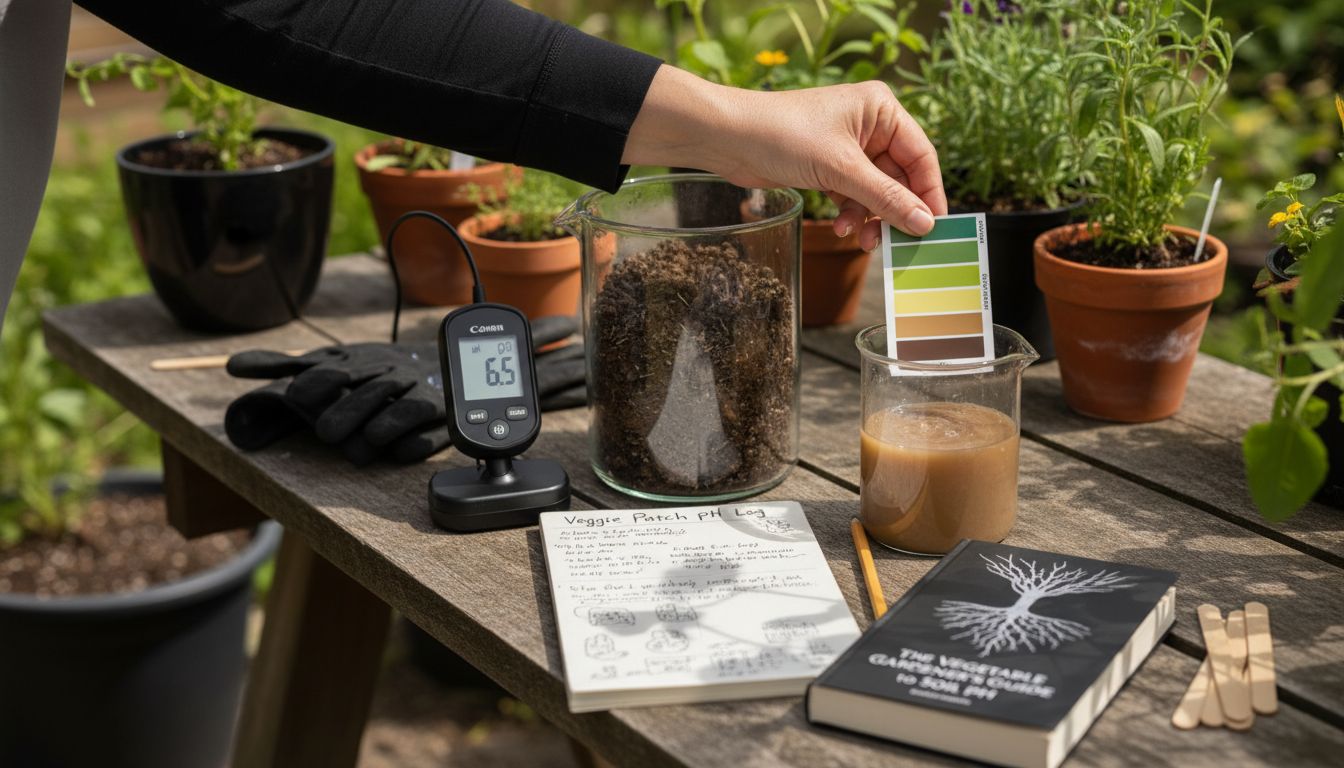Table of Contents
Soil pH shapes everything from plant health to harvest size in a vegetable garden. Over 80 percent of nutrient problems come from soil pH being outside the ideal range for your crops. When soil is too acidic or too alkaline, even the best fertilizers fall short. Understanding soil pH gives you real power to grow stronger, healthier vegetables and avoid frustrating setbacks. This is the knowledge that separates thriving gardeners from those left guessing.
Key Takeaways
| Point | Details |
|---|---|
| Understanding Soil pH is Essential | Soil pH affects nutrient availability, with optimal ranges crucial for vegetable health and growth. |
| Testing is Critical | Regular soil testing helps gardeners determine pH levels and make necessary adjustments for optimal plant nutrition. |
| Targeted Vegetable Selection is Key | Choosing vegetables based on specific soil pH preferences can lead to better crop yields and overall garden success. |
| Adjust pH Carefully | When modifying soil pH, apply amendments gradually and retest regularly to avoid harming plant health. |
What Soil pH Means For Gardeners
Soil pH is a fundamental concept every gardener needs to understand. According to Oregon State University Extension, soil pH measures the acidity or alkalinity of soil on a scale from 0 to 14, with 7 being the neutral midpoint. Values below 7 indicate acidic conditions, while values above 7 represent alkaline environments.
The significance of soil pH goes far beyond a simple numerical measurement. Nutrient availability is critically dependent on your soil’s pH level. When soil becomes too acidic or too alkaline, plants struggle to absorb essential nutrients – even if those nutrients are present in fertilizers. As Yard and Garden explains, pH influences the chemical and biological reactions happening within your garden soil, directly impacting plant growth and health.
For vegetable gardeners, understanding soil pH is like having a secret weapon. Different vegetables thrive in different pH ranges, which means knowing your soil’s specific pH can help you:
- Select the most appropriate vegetable varieties for your garden
- Adjust soil conditions to optimize plant nutrition
- Prevent nutrient deficiencies before they impact crop yield
- Improve overall plant health and resilience
By learning to test and manage your soil’s pH, you transform from a casual gardener into a strategic plant cultivator who can create optimal growing conditions. Understanding the Best Soil for Vegetables offers additional insights into creating the perfect growing environment for your vegetable garden.
Ideal pH Ranges For Vegetable Types
Understanding the specific pH preferences of different vegetables is crucial for successful gardening. According to Aggie Horticulture, each vegetable has unique pH requirements. For instance, asparagus thrives best at a pH of 6.5, with an acceptable range between 6.0 and 7.5, while carrots prefer a similar pH of 6.5 but can tolerate ranges from 5.5 to 7.8.
Vegetable pH Basics reveal that most garden vegetables share some common ground. University of Florida blogs highlight that vegetables generally prefer a soil pH range between 5.8 and 6.3. Interestingly, if your soil pH falls between 5.5 and 7.0, you typically won’t need to make significant adjustments.
Here’s a quick reference for some popular vegetable pH preferences:
- Tomatoes: 6.0 – 6.8
- Peppers: 6.0 – 6.8
- Cucumbers: 6.0 – 7.0
- Lettuce: 6.0 – 7.0
- Spinach: 6.0 – 7.5
- Beans: 6.0 – 7.0
- Potatoes: 5.5 – 6.5
To ensure your vegetables receive optimal nutrition, soil testing becomes a critical step. Understanding the Importance of Soil Testing can provide deeper insights into maintaining the right pH balance for your garden’s success. Remember, while these ranges offer general guidance, individual plant varieties might have slightly different preferences.
How Soil pH Affects Nutrient Uptake
The relationship between soil pH and nutrient availability is complex and critical for plant health. According to Oregon State University Extension, the availability of key nutrients like nitrogen, phosphorus, and potassium is directly influenced by soil pH. When soil pH strays too far from the optimal range, plants encounter significant challenges in nutrient absorption – even when fertilizers are abundantly present.
Nutrient Solubility plays a crucial role in this process. Different nutrients become more or less available depending on the soil’s acidity or alkalinity. For example, most nutrients are most readily available when soil pH is slightly acidic, typically between 6.0 and 6.5. At extreme pH levels, nutrients can become chemically locked, rendering them essentially unavailable to plant roots despite their physical presence in the soil.
Here’s a breakdown of how pH impacts specific nutrient availability:
- Nitrogen: Most available at pH 6.0 – 7.5
- Phosphorus: Optimal absorption at pH 6.0 – 7.0
- Potassium: Performs best at pH 6.0 – 7.5
- Iron: Becomes less available in alkaline soils
- Manganese: Decreases in availability as pH increases
To ensure your vegetables receive maximum nutritional benefits, Soil pH Explained: Complete Guide for Gardeners can help you understand the intricate balance of soil chemistry. Remember, maintaining the right pH isn’t just about adding nutrients – it’s about creating an environment where those nutrients can be effectively absorbed and utilized by your plants.
Testing Your Vegetable Garden’s pH
Knowing your soil’s pH is crucial for successful vegetable gardening. Purdue University Extension recommends getting soil tests when establishing new plants or troubleshooting existing garden issues. A professional laboratory soil test provides the most accurate pH measurements, giving you critical insights into your garden’s underlying soil conditions.
Home gardeners have multiple options for pH testing. While professional lab tests offer the most precise results, there are several accessible methods for determining your soil’s acidity or alkalinity. DIY pH testing kits available at garden centers can provide a quick preliminary assessment, though they’re less accurate than professional analysis. These kits typically involve mixing soil samples with a chemical solution and comparing the resulting color to a standard chart.
Here are the primary methods for testing your vegetable garden’s pH:
- Laboratory Soil Test: Most accurate and comprehensive
- Home pH Testing Kits: Quick and relatively inexpensive
- Digital pH Meters: Provides instant digital readings
- Vinegar and Baking Soda Test: Simple home science experiment
According to Oregon State University Extension, if you make pH adjustments like adding lime, it’s essential to retest your soil three to six months later to confirm the desired pH has been achieved. Vegetable Garden Planning Made Easy can help you integrate pH testing into your overall garden preparation strategy. Remember, consistent monitoring is key to maintaining optimal growing conditions for your vegetables.

Adjusting Soil pH Safely
Successfully modifying your garden’s soil pH requires careful planning and precise application. According to University of California Agriculture and Natural Resources, different materials can be used to raise or lower soil pH, with the amount depending on your current soil conditions and specific soil type. Ground agricultural limestone is the go-to solution for increasing pH, while sulfur or iron sulfate can effectively lower soil acidity.
When raising pH, gardeners typically use lime-based products, which work gradually to neutralize acidic soils. The process isn’t instantaneous – it can take several months for the full effect to manifest. UMass Agriculture emphasizes the importance of careful application and regular testing to avoid over-adjustment, which could harm your vegetable garden’s delicate ecosystem.
Here are key considerations when adjusting soil pH:
- Always start with a precise soil test
- Apply pH amendments in small, incremental amounts
- Wait 3-6 months between applications and retesting
- Consider your specific vegetable types’ pH preferences
- Use organic amendments when possible
To ensure you’re making the right adjustments for your specific garden, Best Compost for Vegetables can provide additional insights into soil management. Remember, patience and precision are your best tools when working to create the perfect growing environment for your vegetables.
Choosing Vegetables Based On Soil pH
Selecting the right vegetables for your garden’s specific soil pH can dramatically improve your growing success. According to Aggie Horticulture, different vegetables have remarkable tolerance ranges. For instance, beets can thrive in a broad pH range from 6.0 to 8.0, while potatoes prefer slightly more acidic conditions between 5.0 and 7.8.
The key is matching vegetable varieties to your existing soil conditions. University of Florida Blogs suggest that most vegetables perform best in a soil pH range of 5.8 to 6.3. If your soil pH falls between 5.5 and 7.0, you likely won’t need significant amendments, making vegetable selection much simpler.
Here’s a quick guide to vegetable pH preferences:
- Acidic Soil Lovers (pH 5.0-6.5):
- Potatoes
- Sweet Potatoes
- Radishes
- Strawberries
- Neutral to Slightly Acidic Soil Lovers (pH 6.0-7.0):
- Tomatoes
- Peppers
- Cucumbers
- Beans
- Lettuce
- More Alkaline Tolerant (pH 6.5-8.0):
- Beets
- Asparagus
- Spinach
Understanding Vegetable Gardening for Beginners can provide additional context for new gardeners navigating the complexities of soil management. Remember, while these guidelines offer a solid starting point, local conditions and specific cultivars can influence optimal growing environments.

Unlock the Full Potential of Your Vegetable Garden with Soil pH Insights
Understanding soil pH is essential for overcoming nutrient uptake challenges and growing healthy vegetables that thrive. Many gardeners face frustration when their plants do not flourish despite proper watering and fertilizing. The secret often lies in your soil’s acidity or alkalinity, which directly affects nutrient availability and plant health. By mastering soil pH concepts like nutrient solubility and optimal pH ranges, you can prevent common problems such as nutrient deficiencies and poor crop yields.
Ready to take control of your garden’s success? Explore practical solutions and expert advice in our Plant Care – Lushy Gardens articles that help you test and safely adjust your soil pH. Pair this knowledge with our guides on Fertilizers – Lushy Gardens to provide your vegetables the nutrition they need to flourish. Visit Lushy Gardens today for trusted gardening tips from Eleanor and start transforming your soil into a vibrant growing foundation. Don’t wait because the right soil pH is the key to a fruitful vegetable garden that rewards your effort.
Frequently Asked Questions
What is soil pH and why is it important for vegetable gardening?
Soil pH measures the acidity or alkalinity of soil on a scale from 0 to 14. It is crucial for vegetable gardening because it affects nutrient availability, plant growth, and overall garden health.
How can I test the pH of my vegetable garden soil?
You can test soil pH using professional laboratory tests for accuracy, or by using DIY pH testing kits, digital pH meters, or even simple home tests with vinegar and baking soda for quick assessments.
What are the ideal pH ranges for various vegetables?
Most garden vegetables thrive in a pH range of 5.8 to 6.3. Specific examples include tomatoes and peppers preferring pH between 6.0 – 6.8, while potatoes thrive in slightly acidic conditions at a pH of 5.5 – 6.5.
How can I safely adjust my garden’s soil pH if it’s not optimal?
To adjust soil pH, use ground agricultural limestone to raise pH or sulfur to lower it. Apply amendments in small amounts, retest the soil after 3-6 months, and consider the specific pH preferences of your vegetables.
Recommended
- Soil pH Explained: Complete Guide for Gardeners – Lushy Gardens
- Understanding the Best Soil for Vegetables: Key Insights – Lushy Gardens
- Best Compost for Vegetables: Complete Essential Guide – Lushy Gardens
- Understanding the Importance of Soil Testing for Gardens – Lushy Gardens
I’m Eleanor, a seasoned gardener with over three decades of experience tending to Mother Nature’s creations. Through Lushy Gardens, I aim to share my wealth of knowledge and help fellow plant enthusiasts uncover the wonders of gardening. Let’s dive into this journey together, one leaf at a time.